Imagine you spent thousands of dollars and countless hours creating your dream house project only for it to fail inspection which then requires you to redo a majority of the work. Undertaking a remodeling or home construction project independently can result in increased costs and time consumption compared to the efficient and skilled services offered by our team at CRD. Our experienced workers, who are both content and proficient in coding, are dedicated to turning your dreams into a tangible reality that passes inspection seamlessly on the first attempt!
Our designers, with years of experience, adhere to proper codes to ensure project approval during inspections. Additionally, we strive to incorporate National Kitchen and Bath Association (NKBA) guidelines, which are suggestions aimed at enhancing the comfort and functionality of living spaces. While NKBA guidelines are not legally mandated, we at CRD prioritize and value them as if they were codes. This commitment reflects our belief in optimizing new spaces to maximize both comfort and space.
Unlike NKBA guidelines, codes must be enforced. So much so that if we touch a space in your house that's out of code, we are responsible for bringing it to code. We want you to be comfortable (by following guidelines) and safe (by upholding code standards).
Amy Moore, CRD Senior Interior Designer, and Andrew Philips, Architectural Designer, each hold over 20 years of experience in the design-build industry, and share their insights that align with how CRD follows codes and guidelines on this podcast. They discuss the various and ever-changing Seattle residential codes and requirements they've followed over the years, emphasizing how these codes contribute to ensuring people's safety.
Listen to our podcast, where Amy and Andrew share personal stories illustrating how they've balanced their clients' desires with safety codes in the past. If podcasts aren't your preference, continue reading below to learn about the National Kitchen and Bath Association (NKBA) guidelines that we follow as best practices.
What's the difference between building codes and NKBA guidelines?
Building codes are the law
Building codes are an area's official rules on building safety. Anyone tackling a construction project (including a homeowner doing DIY work) is legally required to follow these rules. For all but the most minor cosmetic building projects, city inspectors will check to make sure that building codes were followed.
International building codes keep things uniform
Most cities and municipalities choose to adopt a set of universal building codes for residential construction that are developed and updated by the International Code Council (ICC). Collectively, these are referred to as the International Residential Code (IRC). Municipalities can they layer more specific rules on top of the IRC or otherwise amend certain rules.
When planning a project, the IRC is a good starting point, but always check your local codes. Here in Seattle, for instance, we have the Seattle Residential Code (SRC) that includes many amendments to the IRC.
The NKBA offers best practices for bathroom design
The National Kitchen and Bath Association (NKBA) publishes planning guidelines to help interior designers create kitchens and bathrooms that are both functional and safe. These are not legal requirements, like building codes, but they are extremely helpful in ensuring that a bathroom is not only safe but enjoyable to use. NKBA members, like CRD Design Build, refer to these guidelines regularly, as well as our own experience, to design bathrooms that are as functional as they are beautiful.
Continue reading to learn what I consider to be the 16 most important NKBA bathroom design guidelines.
Click here to see the most important NKBA kitchen design guidelines.
Bathroom Building Codes and NKBA Recommendations
While you always have to follow your local code, you'll find that NKBA guidelines either take the code and build upon it or offer recommendations on which the code is silent. Below is a summary of what we consider 16 of the most important NKBA bathroom design guidelines. We also included the relevant codes for comparison.
1. Entry door openings
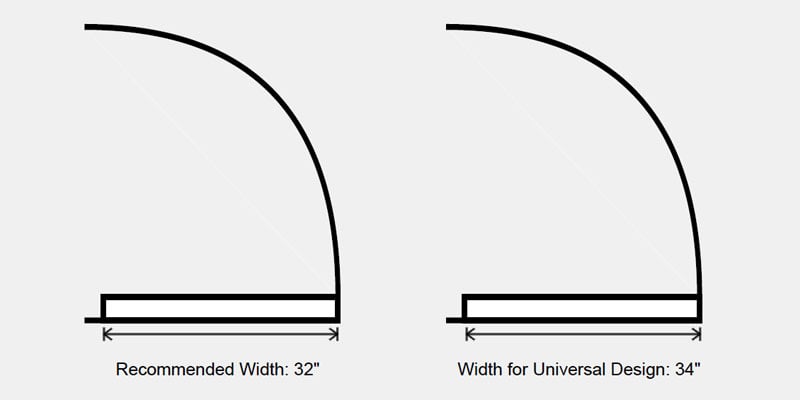
IRC
- The IRC doesn't mention anything about how wide bathroom doors need to be.
NKBA
- Doors should be at least 32" wide.
- For 32" of clear width, the door width (from jamb to jamb) should be 34".
- Since 34" is not a standard door width, most designers spec a 36" door, which is not usually a special order.
- To meet ADA universal design standards, plan on 34" of clear opening, or a 36" door.
- The NKBA makes an exception for situations where it's impossible to fit a 34" door, allowing a 24" door in those circumstances.
- NOTE: If you a remodeling an existing bathroom, most cities will allow the existing door width to remain, even if they have a local code in place requiring a wider door. However, if the location of the door is moved, it usually will have to follow the code.
2. Door interference
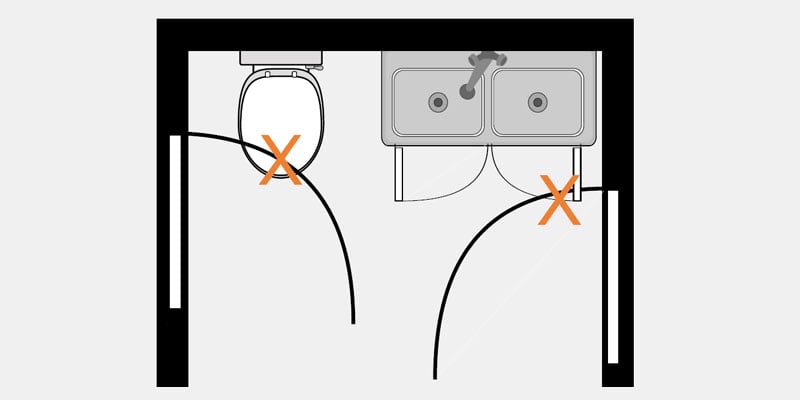
IRC
- Again, the IRC doesn't have any requirements relating to doors bumping into each other in the bathroom.
NKBA
- Good design dictates that the entry door doesn't bump into the shower door or cabinet doors or drawers.
- NOTE: A good way to ensure that you can meet this guideline, even in a small bathroom, is to design an entry door that swings out into the hall instead of into the bathroom.
3. Ceiling height
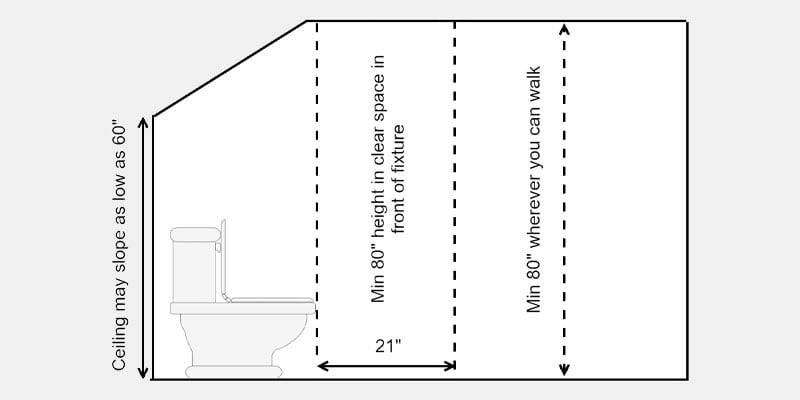
IRC
- Bathrooms must have a minimum ceiling height of 80" in front of fixtures, which is less than the 90" ceiling height required in most rooms.
- The 30" x 30" area in front of a shower head must also be 80" in height.
NKBA
- The NKBA doesn't have anything to add to the IRC requirement in this case.
- The recommended ceiling height over sinks and other fixtures (basically, wherever you can't walk) is only 60".
4. Clear floor space
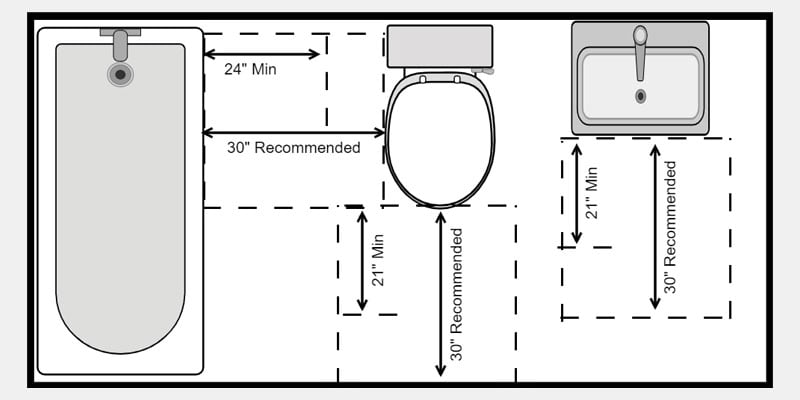
IRC
- At least 21" is required between the toilet, bidet, and sink and any opposite wall or other fixture.
- At least 24" is required in front of the shower entry.
NKBA
- Building code only requires 21" of floor space in front of the toilet or sink, but that feels quite cramped, so the NKBA recommendation is 30".
- NOTE: If you are remodeling an older bath that's just 5' wide, a smaller 21" or 24" clear space may be all you can fit. A wall-hung toilet can help free up space, however.
5. Sink spacing
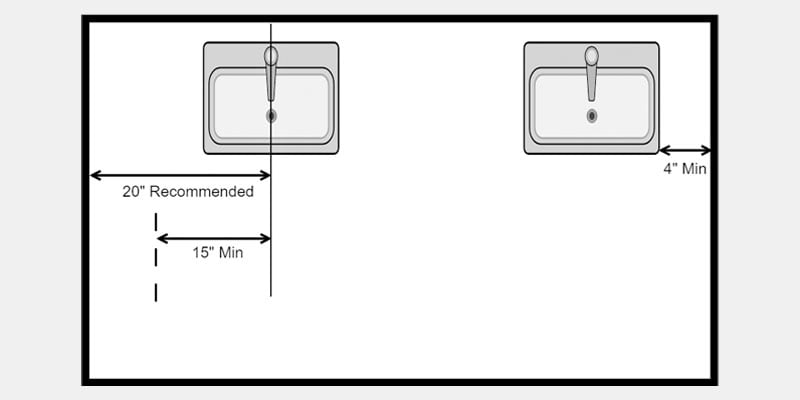
IRC
- The minimum distance from the centerline of the sink to a wall is 15".
- There must be 4" between the edge of a free-standing or wall-hung sink and the wall. (This makes it easier to clean between the edge of the vanity and the wall.)
NKBA
- The NKBA recommends 20" from the center of the sink to the closest wall or other tall obstacle. This extra bit of elbow room makes it more comfortable to wash your hands.
6. Distance between double sinks
IRC
- The distance between the centerlines of two sinks must be at least 30".
- Freestanding or wall hung sinks should have at least 4" of space between them.
NKBA
- The NKBA recommends at least 36" between the centerlines of two sinks. When in doubt, go with smaller sinks so there is more room in between. This extra space ensures that you won't bump elbows with the person using the sink next to you.
7. Vanity height
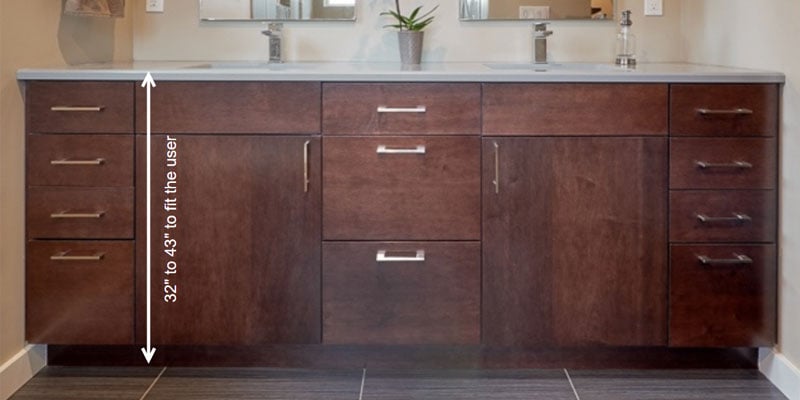
IRC
- No code requirement for vanity height.
NKBA
- Vanities should be 32" - 34" in height. In the old days, 32" vanities were the norm, with the goal of accommodating both kids and adults. Nowadays, standard practice is to customize them to be comfortable for adult users. Kids can use stools, which can even be on a pull-out mechanism built into the vanity.
8. Countertop corners
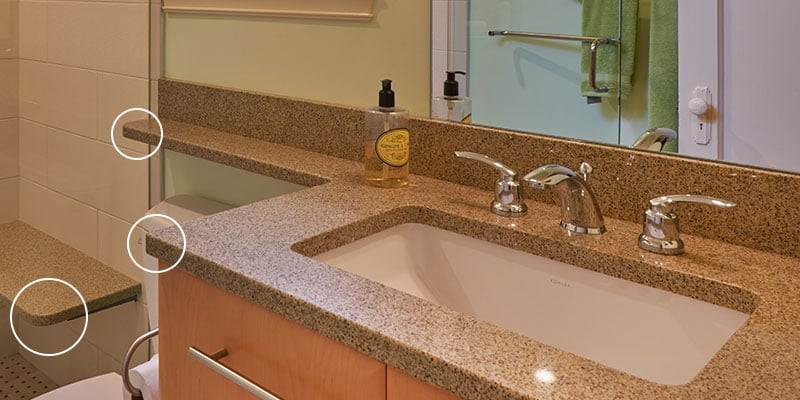
IRC
- The IRC is silent on this one.
NKBA
- Countertop corners shouldn't be sharp.
- Chamfered or rounded corners should be installed for safety.
9. Shower size
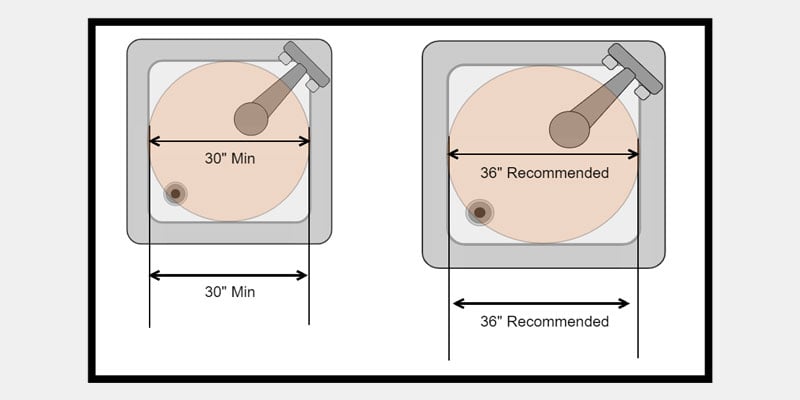
IRC
- The minimum interior shower size is 30" x 30" or 900 square inches, in which a disk of 30" in diameter must fit. (In most places, the shower head must also be inside this imaginary disk.)
NKBA
- The code minimum is 30" x 30", but 36" square is much more comfortable.
10. Grab bars
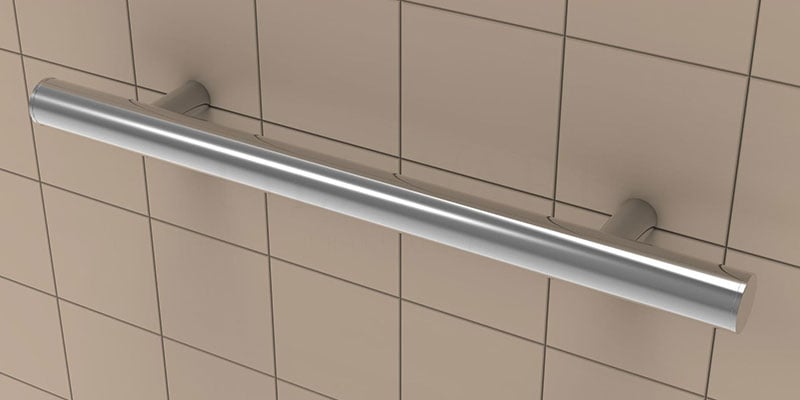
IRC
- There are no international code prescriptions for grab bars.
NKBA
- Plan grab bars. Even if you don't need them now, grab bars (or blocking within the walls) should be installed 33" - 36" above the floor in the shower.
11. Non-slip floors
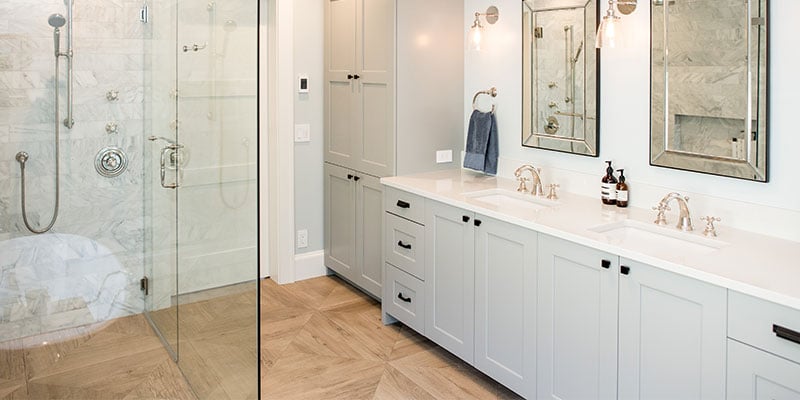
IRC
- No international code requirements for flooring type.
NKBA
- The NKBA recommends non-slip floors. Don't install any slippery flooring in your bathroom (including your shower floor). Ceramic tile floors should have a coefficient of friction (COF) rating of at least 0.5 when wet.
12. Toilet placement
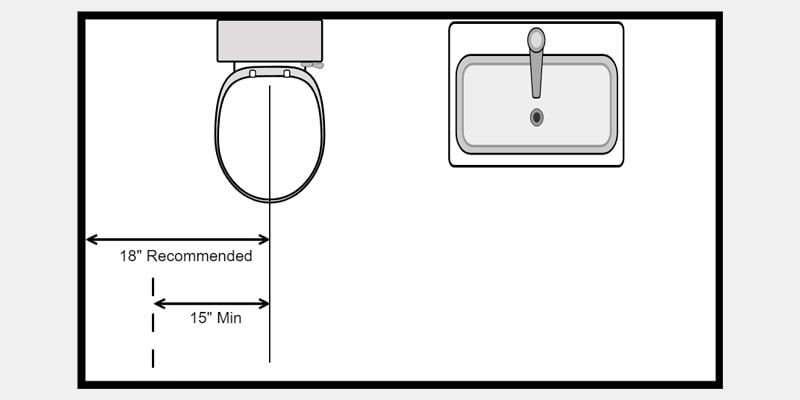
IRC
- A minimum distance of 15" is required from the centerline of a toilet to any bath fixture, wall, or other obstacle.
NKBA
- Give your toilet some space. The distance from the centerline of your toilet bowl to the nearest wall or obstacle should be at least 18". Only use the 15" minimum code requirement if you have a very small bathroom and can't accommodate the extra distance.
13. Toilet compartments
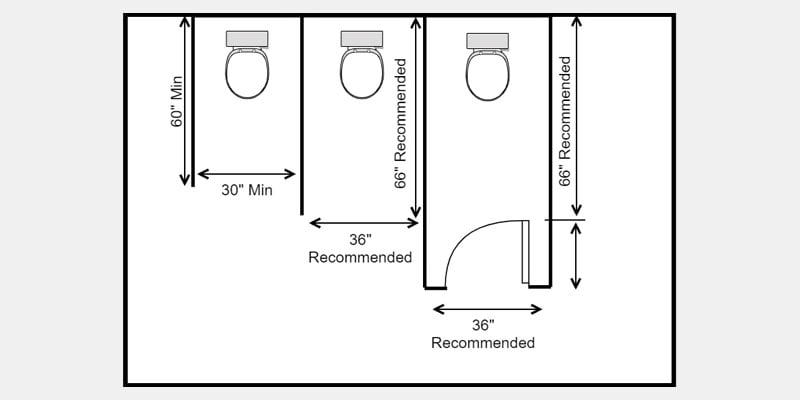
IRC
- The minimum size for a separate toilet compartment is 30" by 60".
NKBA
- When it comes to toilet compartments (also known as water closets or WCs), the NKBA recommends a larger space of 36" x 66".
- If you have a swing-out or pocket door, you can use these minimum dimensions. If the door swings in, add the width of the door to the depth of the WC.
14. Bathroom accessories
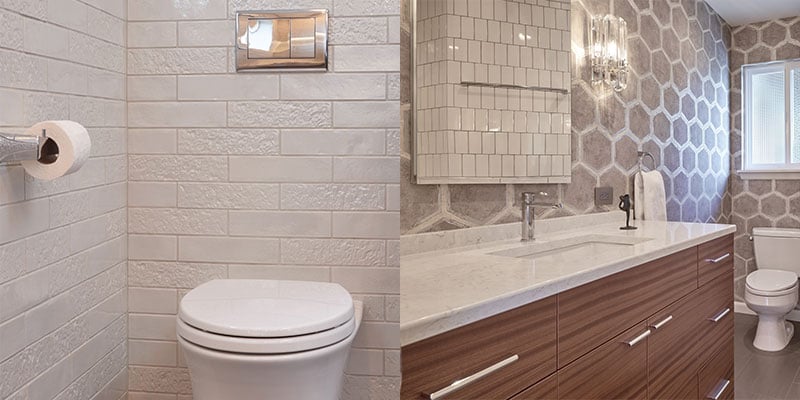
IRC
- The IRC doesn't require the placement of any accessories.
NKBA
- The NKBA recommends the placement of accessories with an eye to ergonomics.
- A mirror should be placed over the sink with eye height in mind, the toilet paper holder should be 8" - 12" in front of the edge of the toilet bowl, and towel holders and soap dishes should be conveniently located.
15. Ventilation
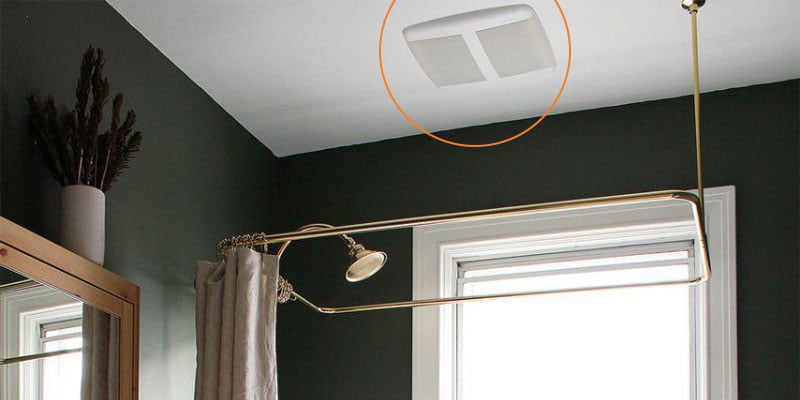
IRC
- Minimum ventilation for the bathroom is to be a window of at least 3 sq. ft. of which 50% is operable, or a mechanical ventilation system of at least 50 cubic feet per minute (cfm) ducted to the outside.
NKBA
- An exhaust fan that is vented to the outside of your home should be placed in each bathroom.
- If your shower compartment or WC is fully enclosed, they are considered their own room and should have their own exhaust fans.
See also: A Practical Guide to Window Placement
16. Heating
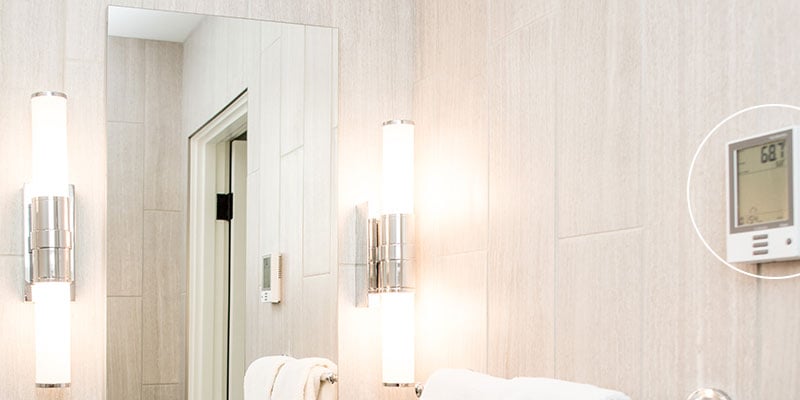
IRC
- All bathrooms should have an appropriate heat source to maintain a minimum room temperature of 68° Fahrenheit (20° Celsius).
NKBA
- The NKBA recommends that the bathroom should be about 10 degrees warmer than the rest of the house when someone is bathing.
- Consider installing a supplemental heat source in the bathroom if needed.
Kitchen Building Codes and NKBA Recommendations
While you always have to follow your local code, you'll find that NKBA guidelines either take the code and build upon it or offer recommendations on which the code is silent. Below is a summary of the 31 NKBA kitchen design guidelines for full-scale kitchen design. We also included the relevant codes when applicable.
1. Kitchen entry door openings
Narrow doors are constricting and give a kitchen a closed-off feel. For the sake of universal design, we recommend 36" doors wherever possible.
IRC
- No specific IRC requirements.
NKBA
- Doors should be at least 32" wide.
- For 32" of clear width, the door width (from jamb to jamb) should be 34".
- Since 34" is not a standard door width, most designers spec a 36" door, which is not usually a special order.
- To meet ADA universal design standards, plan on 34" of clear opening, or a 36" door.
NOTE: If you are remodeling an existing kitchen, most cities will allow the existing door width to remain, even if they have a local code in place requiring a wider door. However, if the location of the door is moved, it usually will have to follow the code.
2. Kitchen door interference
-copy.jpg?width=800&height=400&name=2a-(2)-copy.jpg)
Here's a common-sense recommendation: Design your kitchen so appliance doors (and regular doors) don't bump into one another. A good way to ensure that you can meet this guideline, even in a small kitchen, is to design an entry door that swings out into the hall instead of into the kitchen.
IRC
- The IRC doesn't have any requirements relating to doors bumping into each other in the kitchen.
NKBA
- No entry door should interfere with the safe operation of appliances.
- Nor should appliance doors interfere with one another.
3. Distance between work centers
-1.jpg?width=800&height=400&name=3a-(1)-1.jpg)
If you divide a kitchen up into its functional components, you come up with the idea of "work centers." Simply put, these are the stove, the sink/prep area, and the refrigerator. Traditionally, this has been called the kitchen work triangle, and idea that dates back many decades. Since then, more work centers have made their way into kitchens, such as dishwashers, second sinks, warming drawers, etc. While not part of the building code, the kitchen work triangle concept still has validity, and cooking and cleanup flows smoother when the important functional areas are close at hand.
See also: Kitchen Layout 101: The Work Triangle and Zones
IRC
- The IRC is silent on this point.
NKBA
- In a kitchen with three work centers (cooking, cleanup/prep, and refrigerator), the sum of the distances between them should total no more than 26 feet.
- No leg of the work triangle should measure less than 4 feet nor more than 9 feet.
- When the kitchen includes additional work centers, each additional distance should measure no less than 4 feet nor more than 9 feet.
- No work triangle leg should intersect an island or peninsula by more than 12 inches.
4. Separating work centers
.jpg?width=800&height=400&name=4a-(1).jpg)
This rule complements the work triangle idea above. If the goal is easy movement between important work centers in the kitchen, it's important not to block the way with large objects.
IRC
- No IRC requirements relating to separating work centers.
NKBA
- A full-height, full-depth, tall obstacle [i.e., a pantry cabinet or refrigerator] should not separate two primary work centers.
5. Work triangle traffic
-1.jpg?width=800&height=400&name=5a-(1)-1.jpg)
In an ideal world, people wouldn't have to walk right through where the cook is cooking. However, it's impossible to adhere to this guideline if you have a galley kitchen that is open on each end. We also see plenty of kitchens that have an exterior door, perhaps to a deck or patio, at the back of the kitchen. As long as family members and guests aren't constantly passing through the work triangle, your kitchen will still be functional.
IRC
- There aren't any code restrictions against people needing to walk through a kitchen to access another room or an exterior door.
NKBA
- No major traffic patterns should cross through the work triangle.
See also: Timeless Kitchen Design
6. Work aisle
.jpg?width=800&height=400&name=6a-(1).jpg)
"Work aisle" is just a fancy way of saying "walking space between countertops." At CRD, we've been known to distinguish between "one-butt kitchens" and "two-butt kitchens." If you and your partner, for instance, like to cook together, it's important to follow the NKBA's recommendation and design ample space for the two of you to walk past each other without bumping into one another or the countertop.
IRC
- Nothing to see here. The IRC doesn't comment on kitchen work aisles.
NKBA
- The width of a work aisle should be at least 42 inches for one cook and at least 48 inches for multiple cooks.
- The work aisle is the measurement between the fronts of your countertops, tall cabinets, and appliances.
NOTE: This rule usually applies to galley kitchens or kitchens with islands. If you have to choose between extra deep counters and work aisle space, I recommend you go with the latter. Extra counter space is great, but even more important is your ease of movement around your kitchen.
7. Walkways
.jpg?width=800&height=400&name=7-(1).jpg)
First, a definition. What's the difference between a work aisle (defined above) and a walkway? The NKBA distinguishes between the place where the cook stands while cooking or cleaning up (the work aisle) and a walkway, which is simply a passageway for others to walk through the kitchen. The minimum space for a work aisle is quite a bit more generous than for a walkway. That's because a cook needs to be able to turn around, bend over to reach items out of lower cabinets, and pull hot pans of chocolate chip cookies out of the oven. (Mmm, cookies!)
IRC
- Again, the IRC doesn't specifically comment on walkway width.
NKBA
- The width of a walkway should be at least 36 inches.
- If two walkways are perpendicular to each other, one walkway should be at least 42 inches wide.
8. Traffic clearance for seating
.jpg?width=800&height=400&name=8-(1).jpg)
If you have a seating area built into your kitchen (most commonly a "breakfast bar"), you need to make sure there is enough space behind seated individuals. The required space varies depending on whether people need to be able to walk past, slide past, or don't need to pass by the seated individual at all.
IRC
- The IRC doesn't dictate traffic clearance for seating.
NKBA
- In a seating area where no traffic passes behind a seated diner, allow 32 inches of clearance from the counter/table edge to any wall or other obstruction behind the seating area.
- If traffic passes behind the seated diner, allow at least 36 inches to slide past or at least 44 inches to walk past.
- Any seating area with more than one seat requires a minimum of 36 inches of clearance.
NOTE: Wheelchair access in a seating area requires a minimum of 44" of clearance.
9. Seating space
.jpg?width=800&height=400&name=9-(1).jpg)
To be comfortable while you're seated, you need plenty of knee and elbow room. If you are wondering if you have space for a breakfast nook, keep in mind that these knee-space guidelines apply to kitchen nook dimensions as well.
IRC
- The IRC doesn't rule on seating space.
NKBA
- Kitchen seating should be a minimum of 24-inch wide for each person and:
- For 30-inch high tables/counters, a minimum 18-inch deep clear knee space for each seated diner.
- For 36-inch high counters, a minimum 15-inch deep clear knee space for each seated diner.
- For 42-inch high counters, a minimum 12-inch deep clear knee space for each seated diner.
10. Cleanup/prep and sink placement
.jpg?width=800&height=400&name=10aa-(1).jpg)
The effect of this rule is to prevent the refrigerator or stove being installed along the same wall as the sink. Given that your sink is the center of your food prep efforts, it's just easier to access those other work centers by turning 90 or 180 degrees on your heel than it would be to walk back and forth along one wall. This is a great rule in theory, but occasionally it can backfire if your kitchen has a very wide U-shape floorplan, which would require you to walk several paces from your sink to reach your appliances.
IRC
- The IRC doesn't regulate the placement of kitchen sinks.
NKBA
- If a kitchen has only one sink, locate it adjacent to or across from the cooking surface and refrigerator.
11. Cleanup/prep sink landing area
.jpg?width=800&height=400&name=11a-(1).jpg)
There are few things that ruin the ergonomics of a kitchen faster than insufficient counter space on each side of the sink. If you've ever tried to wash dishes in a kitchen in which the sink was located right next to a wall or refrigerator, you know what I'm talking about.
IRC
- The IRC doesn't have any rules relating specifically to prep sink placement.
NKBA
- Include at least a 24-inch wide landing area to one side of the sink and at least an 18-inch wide landing area on the other side.
12. Food preparation work area
.jpg?width=800&height=400&name=12-(1).jpg)
Every cook knows you need room to chop veggies, measure ingredients, and mix up the chocolate chip cookie dough. (There we go again!) The NKBA specifies a wide swath of countertop next to a sink for the cook's primary prep area. And, if you're like most people, your cleanup and prep areas center around the same sink, so this rule essentially supersedes Rule #11 above.
IRC
- The IRC doesn't dictate food prep areas.
NKBA
- Include a section of continuous countertop at least 30 inches wide by 24 inches deep immediately next to a sink for a primary preparation/work area.
See also: The One Thing You Need to Know about Great Kitchen Design
13. Dishwasher placement
.jpg?width=800&height=400&name=13-(1).jpg)
This one is a no-brainer! Place your dishwasher near the sink and leave some space on either side of the door when it swings open.
IRC
- The IRC doesn't specify anything about dishwasher placement as it relates to the sink.
NKBA
- Locate nearest edge of the primary dishwasher within 36 inches of the nearest edge of a cleanup/prep sink.
- Provide at least 21 inches of standing space between the edge of the dishwasher and countertop frontage, appliances and/or cabinets placed at a right angle to the dishwasher.
14. Waste receptacles
.jpg?width=800&height=400&name=14%20(1).jpg)
If you're deep in the zone, cooking up a meal, you don't want to have to pause constantly to walk to the other side of the room to throw away some scraps or packaging.
IRC
- The IRC doesn't get into waste receptacle placement.
NKBA
- Include at least two waste receptacles.
- Locate one near the sink(s) and a second for recycling in the kitchen or nearby.
15. Auxiliary sink
.jpg?width=800&height=400&name=15-(1).jpg)
If you have an extra sink, say in your kitchen island, it needs to have a bit of counter space on each side.
IRC
- You guessed it! The IRC doesn't comment on auxiliary sink placement.
NKBA
- At least 3 inches of countertop frontage should be provided on one side of the auxiliary sink and 18 inches on the other side.
16. Refrigerator landing area
.jpg?width=800&height=400&name=16-(1).jpg)
It's essential to have counter space close at hand for loading and unloading your refrigerator.
IRC
- The IRC is silent on this point.
NKBA
- Include at least 15 inches of landing area on the handle side of the refrigerator
- OR 15 inches of landing area on either side of a side-by-side refrigerator
- OR 15 inches of landing area no more than 48 inches across from the front of the refrigerator
- OR 15 inches of landing area above or adjacent to any under-counter refrigeration appliance
17. Cooking surface landing area
.jpg?width=800&height=400&name=17-(1).jpg)
Landing areas are just as important for cooktops as they are for refrigerators. If your stove is mounted higher or lower than the rest of your countertops (not something I normally recommend), the landing area should be at the height of the cooktop. You don't want hot pans to slide off the edge of the cooktop or be boxed in.
IRC
- No specific requirements from the IRC on this point.
NKBA
- Include a minimum of 12 inches of landing area on one side of a cooking surface and 15 inches on the other side.
- If the cooking surface is at a different countertop height than the rest of the kitchen, then the 12-inch and 15-inch landing areas must be at the same height as the cooking surface.
- For safety reasons, in an island or peninsula situation, the countertop should also extend a minimum of 9 inches
behind the cooking surface if the counter height is the same as the surface-cooking appliance. - For an enclosed configuration, a reduction of clearances shall be in accordance with the appliance manufacturer’s instructions or per local codes. (This may not provide adequate landing area.)
18. Cooking surface clearance
.jpg?width=800&height=400&name=18%20(1).jpg)
For fire safety, you need plenty of space between the top of your stove and the surface above it. A non-combustible surface usually means a range hood.
IRC
- At least 30 inches of clearance is required between the cooking surface and an unprotected/combustible surface above it. (IRC M 1901.1)
- If a microwave hood combination is used above the cooking surface, then the manufacturer’s specifications should be followed. (IRC M 1504.1)
NKBA
- Allow 24 inches of clearance between the cooking surface and a protected noncombustible surface [e.g., a range hood] above it.
See also: 5 of the Most Durable Kitchen Materials
19. Cooking Surface Ventilation
An exhaust fan over your cooktop (or incorporated into it) is essential in the kitchen, and it needs to have sufficient flow to be effective. In newer, more airtight homes, you need some way to replace the air that is exhausted.
IRC
- Manufacturer’s specifications must be followed. (IRC G 2407.1, IRC G 2447.1)
- The minimum required exhaust rate for a ducted hood is 100 cfm and must be ducted to the outside. (IRC M 1507.3)
- Make-up air may need to be provided. Refer to local codes. (IRC G 2407.4)
NKBA
- Provide a correctly sized, ducted ventilation system for all cooking surface appliances; the recommended minimum is 150 CFM.
20. Cooking Surface Safety
.jpg?width=800&height=400&name=20%20(3).jpg)
Window curtains above a stove are an obvious no-no. A window that opens and lets in the breeze could blow out the gas flame on your range and create a different sort of safety hazard.
IRC
- The IRC doesn't require anything specific here, but common sense dictates not putting flammable materials over the stove.
NKBA
- Do not locate the cooking surface under an operable window.
- Window treatments above the cooking surface should not use flammable materials.
- A fire extinguisher should be located near the exit of the kitchen away from cooking equipment.
See also: Here's What To Do After a Fire
21. Microwave Oven Placement
.jpg?width=800&height=400&name=21%20(1).jpg)
Most microwaves are placed too low for ease of use. Ideally, the bottom of a microwave will be a few inches below the top of the user's shoulders. Under-counter drawer-style microwaves are an ergonomic alternative, but they shouldn't be mounted too low to the floor.
IRC
- There are no specific IRC microwave placement guidelines.
NKBA
- The ideal location for the bottom of the microwave is 3 inches below the principle user's shoulder but no more than 54 inches above the floor.
- If the microwave is below the countertop the bottom must be at least 15 inches off the finished floor.
22. Microwave Landing Area
.jpg?width=800&height=400&name=22%20(1).jpg)
Wherever you place your microwave, it should have a handy countertop spot nearby to set a hot plate on when you pull it out of the appliance.
IRC
- The IRC tends not to focus on convenience or ergonomics, so it is silent on this point.
NKBA
- Provide at least a 15-inch landing area above, below or adjacent to the handle side of a microwave oven.
23. Oven Landing Area
.jpg?width=800&height=400&name=23-(1).jpg)
An oven needs a bit of countertop on either side on which a hot pan can be placed. If there isn't room next to the oven, that's okay, as long as there is some free countertop space directly across from it.
IRC
- Nothing from the IRC on this point.
NKBA
- Include at least a 15-inch landing area next to or above the oven.
- At least a 15-inch landing area not more than 48 inches across from the oven is acceptable if the appliance does not open into a walkway.
24. Combining Landing Areas
.jpg?width=800&height=400&name=24-(1).jpg)
By this point, you may be wondering how all of the NKBA recommendations can possibly work together. If every appliance needs its own dedicated landing area, and good design dictates that appliances can't be too far apart, how does it all fit together? NKBA's solution is the combined landing zone. You take the larger of the two overlapping landing zones, add a foot, and you're done. After all, the same space can be used for a hot pan from the oven and a gallon of milk from the fridge!
IRC
- Keep moving. Nothing to see here.
NKBA
- If two landing areas are adjacent, determine a new minimum by taking the longer of the two landing area requirements and adding 12 inches.
25. Countertop Space
.jpg?width=800&height=400&name=25-(1).jpg)
In our mind, this should be rule #1! Countertop space is so important to good kitchen design. If you plan to use many small countertop appliances, like a microwave, a toaster, or a coffee maker, then plan for even more countertop space than the recommendation.
IRC
- There is nothing specific in the IRC about counter space.
NKBA
- A total of 158 inches of countertop frontage, 24 inches deep, with at least 15 inches of clearance above, is needed to accommodate all uses.
26. Countertop Edges
.jpg?width=800&height=400&name=26-(1).jpg)
Rounded or chamfered countertop corners are not only safer, but they are less prone to chipping if your countertop is a solid surface, like natural stone or quartz.
IRC
- The IRC doesn't specify anything on this point.
NKBA
- Specify clipped or round corners rather than sharp edges.
See also: 10 Advantages of Quartz Countertops Over Granite
27. Storage
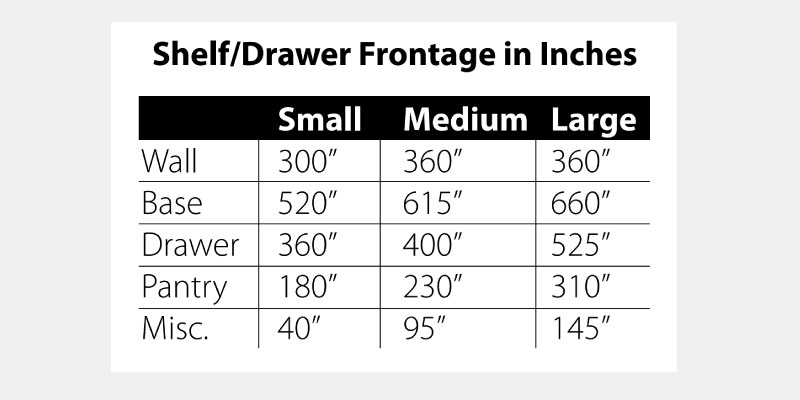
Ample, well-designed storage is another must for a functional kitchen. The larger the kitchen, the more shelves and drawers it should have.
IRC
- Nothing in the IRC about storage space.
NKBA
- The total shelf/drawer frontage is:
- 1,400 inches for a small kitchen (150 square feet or less)
- 1,700 inches for a medium kitchen (151 to 350 square feet);
- 2,000 inches for a large kitchen (351 square feet or more).
- The totals for wall, base, drawer, and pantry shelf/ drawer frontage can be adjusted upward or downward as long as the recommended total stays the same.
- Do not apply more than the recommended amount of storage in the miscellaneous category to meet the total
frontage recommendation. - Storage areas that are more than 84” above the floor must be counted in the miscellaneous category.
- Shelf and drawer frontage is determined by multiplying the cabinet size by the number and depth of the shelves or drawers in the cabinet, using the following formula:
- Cabinet width in inches x number of shelves and drawers x cabinet depth in feet (or fraction thereof ) =
Shelf and Drawer Frontage
- Cabinet width in inches x number of shelves and drawers x cabinet depth in feet (or fraction thereof ) =
- Storage/organizing items can enhance the functional capacity of wall, base, drawer, and pantry storage, and should be selected to meet user needs.
28. Storage at Cleanup/Prep Sink
Kitchens need lots of storage space, but they also need a good portion of that space to be easily accessible from the main sink area. While cooking and cleaning up, you need ready access to utensils, spices, and cleaning items.
IRC
- Not applicable.
NKBA
- Of the total recommended shelf/drawer frontage, the following should be located within 72 inches of the centerline of the main cleanup/prep sink:
- At least 400 inches for a small kitchen;
- At least 480 inches for a medium kitchen;
- At least 560 inches for a large kitchen.
29. Corner Cabinet Storage
.jpg?width=800&height=400&name=29%20(1).jpg)
Good design means putting every space to good use. Corner cabinet space is sometimes underutilized or inaccessible.
IRC
- Believe it or not, the IRC doesn't have an opinion on corner cabinet storage, or any kitchen cabinet storage for that matter.
NKBA
- At least one corner cabinet should include a functional storage device.
- This guideline does not apply if there are no corner cabinets.
See also: What To Do with the #%$@ Corner Cabinet? Kitchen Corner Cabinet Design
30. Electrical Receptacles
.jpg?width=800&height=400&name=30%20(1).jpg)
What are those little buttons in the middle of some of your receptacles that pop out and shut off the power? They're part of a ground-fault interrupt system that could save your life! GFCI outlets are required in damp environments like kitchens to help prevent shock by instantly depowering if they detect a fault.
IRC
- GFCI (Ground-fault circuit interrupter) protection is required on all receptacles servicing countertop surfaces
within the kitchen. (IRC E 3802.6)
NKBA
- Refer to IRC E 3801.4.1 through E 3801.4.5 for receptacle placement and locations.
See also: What Happens if You Get Caught Remodeling without a Permit?
31. Lighting
Proper lighting is essential in a kitchen. You will want a good combination of natural light, general all-around light, and task lighting. Pendants and under-cabinet lighting serve well for the latter.
IRC
- At least one wall-switch controlled light must be provided. Switch must be placed at the entrance. (IRC E 3803.2)
- Window/skylight area, equal to at least 8% of the total square footage of the kitchen, or a total living space which includes a kitchen, is required. (IRC R 303.1, IRC R 303.2)
See also: A Practical Guide to Window Placement
NKBA
- In addition to general lighting required by code, every work surface should be well illuminated by appropriate
task lighting.
Putting it all together
We hope that sharing the NKBA guidelines and Seattle City codes we follow solidifies the trust you have in us here at CRD Design Build. We focus on building trust in all of the clients we work with as relationship building is a fundamental part of design-build. Don't hesitate to speak to an experienced interior designer to truly optimize your new kitchen/bathroom layout (and ensure you don't run afoul of your local building code). Your designer will present you with several room layouts to choose from, each conforming to these design standards and optimized for your unique needs. It's amazing how much a custom-designed kitchen or bathroom can add to your enjoyment of your home and quality of life.
Our interior designers here at CRD Design Build would be happy to discuss your kitchen and bathroom remodeling plans. Please feel free to drop us a line to discuss your dream space. We would love to be of service!
Guide to Hiring a Remodeler
This comprehensive guide walks you through all the steps of choosing who will design and build your project, vetting remodeling companies, and ensuring that you have the best experience.

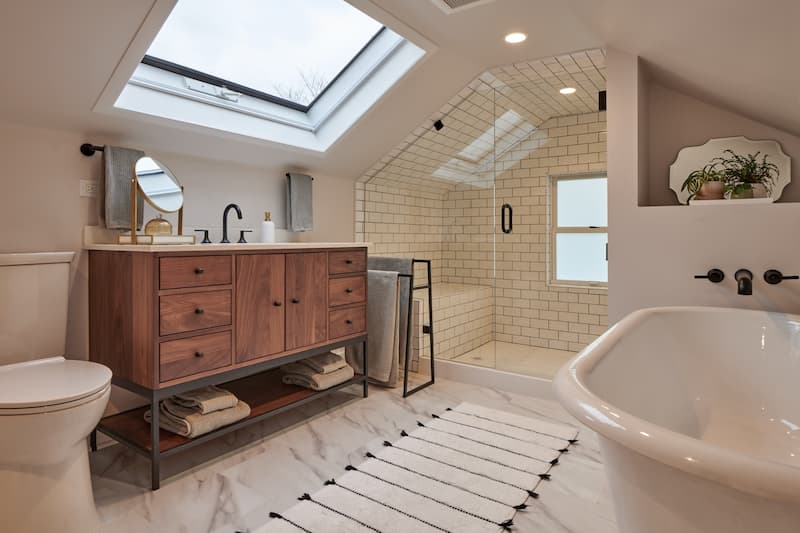
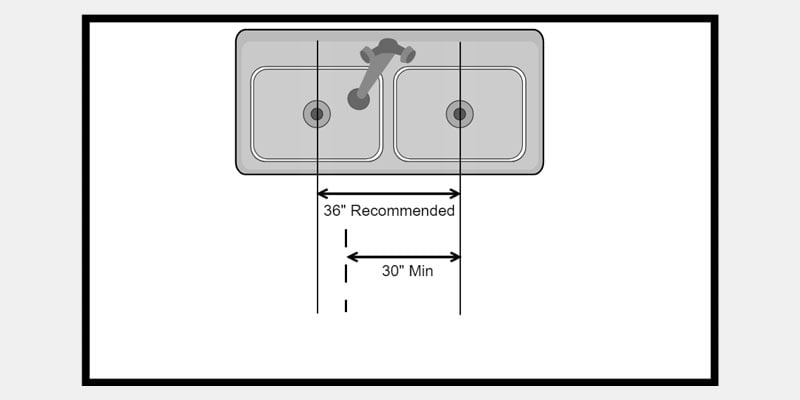
.jpg?width=800&height=400&name=19a-(1).jpg)


